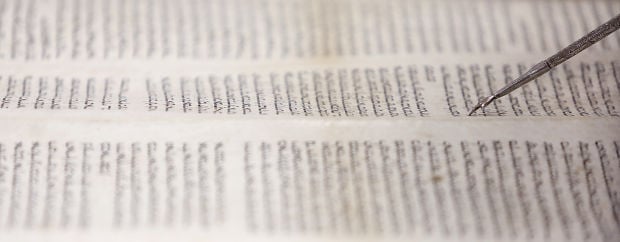A 200-year-old torah scroll at the University of Arizona has many secrets hidden within the wear and tear that a Jewish scribe will look at this week.
On Tuesday and Wednesday, the university’s Arizona Center for Judaic Studies will welcome Rabbi Gedaliah Druin, the president of Sofer On Site, a North Miami Beach, Florida-based organization that specializes in caring for torah scrolls.
This is the UA’s first and only torah scroll, which contains the first five books of the Hebrew Bible, spanning Genesis through Deuteronomy. The torah is sung in services at Jewish synagogues.
“You’re singing to something that is unexpected and beyond our imaginations,” said Druin, a master sofer, or scribe. “This is like an instrument calling up God.”
THE HISTORY
Beyond the divine mysteries contained within the torah’s stories, the UA’s scroll has a history of its own.
The intrigue began in 2009 when an anonymous donor gifted the Judaic studies center with its first torah.
“A colleague of mine at USC who works with the Dead Sea Scrolls and other ancient scrolls contacted me and asked me if I would accept this on behalf of the department,” said Beth Alpert Nakhai, an associate professor with the Judaic studies center.
A rare-book dealer from Santa Barbara, California, facilitated the anonymous donation, and one day an old cardboard box stuffed with newspaper showed up.
The center had its torah.
“It wasn’t even a new cardboard box!” Nakhai said, laughing. “For something that is this old and expensive financially and precious materially and spiritually and all of that, I expected that it would come packed better, but it was fine.”
The story of this torah’s origin is foggy. From the script, experts have told Nakhai that the scroll was written by a European Sephardic Jewish community about 200 years ago, perhaps in Amsterdam or northern Italy.
There may be no way to know for sure, she said.
“When it comes to a Sephardic community, that means it had originally lived on the Iberian Peninsula and was expelled at the time of the Inquisition, and moved someplace and apparently kept their identity distinct,” Nakhai said.
This particular scroll managed to escape the destruction of World War II, somehow ending up in Israel.
“The person who donated it, I was told, had purchased it in Israel,” Nakhai said. “How it survived the Second World War and got to Israel — or maybe it was in Israel before the war — we have absolutely no idea.
“I think these are the kinds of mysteries that we may never have the answers to.”
THE RESTORATION
What the center does know is that reading a torah scroll is hard work.
Written in the original tradition, the text in torah scrolls does not have vowels or punctuation.
“There are just consonant sounds,” said Zach Neal, a UA junior. “If you don’t know the word, you can’t pronounce it.”
The scroll is now housed at the university’s Special Collections library and is used as a teaching tool for students learning Hebrew or taking a class about the Bible.
Along with Druin’s restoration efforts, which are a continuation of work done by another of his organization’s scribes last February, the Judaic studies center plans to purchase ornaments currently missing from the scroll, such as rollers and a mantle, which is a cover.
“If we did nothing to this scroll, we could always use it for teaching, but because there are letters in poor shape, it is not kosher,” Nakhai said.
In synagogues, scrolls that cannot be restored to a state deemed kosher are no longer used. Although that does not affect the UA’s use of the scroll for academic purposes, a kosher status also indicates that the scroll is “restored to its highest quality possible.”
Once that happens, there are plans for the torah scroll to be put on display at the Judaic studies center, she said.
“It’s a hugely important symbol within Judaism, beyond the text itself,” Nakhai said. “There is a reason that Nazis burned torahs and inquisitorial peoples of Spain and Portugal burned torahs.
“It represents a core of divine revelation in terms of religious understanding and teaching.”





